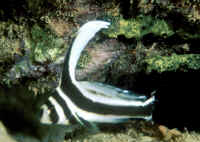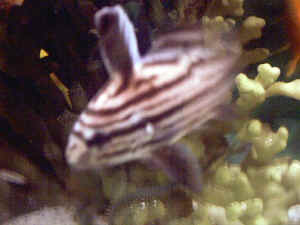|
FAQs about Croakers, Drums, Family
Sciaenidae
Related Articles: Croakers,
Drums,
Related FAQs:
Equetus punctatus juvenile off St. Lucia.
|

|
croaker fish enquiry 11/25/15
hello.
please am from Nigeria and i want to go into croaker fish business, that why am
mailing to know more about croaker fish.
<Can be cultured.... some species are; as food and game fish (often under other
names; the White Seabass, Cynoscion nobilis is a croaker here in California).
You need to get to a large, college library, seek the help of a reference
librarian.... And/or ask in your country re "fisheries extension services" from
the government. Other species (e.g. Tilapia, Oreochromis) are easier to produce.
Bob Fenner>
Stocking list; Equetus acuminatus -- 02/05/10
Thanks
I was thinking, could I go for a high hat drumfish for my 150 gallon?
My stocking list consists of
1 harlequin tusk
1 snowflake eel
1 yellow tang
1 Blackspotted puffer
1 Picasso trigger
<Might be bullied by puffer, trigger, Tuskfish and eel'¦ Is
a rather docile, partly shy species and the long fin is an invitation
to nip at. Also, your tank will become quite full. You'll need very
good filtration and regular water changes to keep the water parameters
in line as these fishes grow. Try entering the drumfish or other
possible fish you are thinking about into the WWM search bar found at
the bottom of each page to find information on compatibility/character.
Cheers, Marco.>
Severe trembling Hi all, I saw something unusual yesterday
and am concerned about it. I have a Jackknife drum (Equetus
lanceolatus), which is pretty unusual in itself. I have had
the fish since July '02. I recently moved it to a new
large (110) tank. Yesterday I entered the room and startled
the 3 fish in there, they all scattered and the jackknife went into
some sort of convulsive trembling, similar to what clownfish do but far
more violent. I thought he was just going to drop dead right
then and there. The trembling lasted for 30-40 seconds and
then he just snapped out of it and has acted normal for the past 24
hours, although he did not eat last night which is very
unusual. This fish has been a major chore to keep, I think
they are rare in the trade because they are very delicate in captivity.
<These little croakers (family Sciaenidae) from the tropical West
Atlantic used to be more popular in decades past... but have been
largely supplanted with more exotic, less-expensive Indo-Pacific
species in our interest> He has contracted and survived
Brooklynella twice and the slightest stress ( like a water change or
tank cleaning) will cause an outbreak of crypto. This is the
first time I ever saw this trembling behavior, any
thoughts? - D <I have seen this behavior (in
the wild) and suspect it is "natural" and can imagine some
"species and individual survival value"... a potential
predator might be put off by the shaking... And agree with your
analysis of the added stress from being moved, perhaps shocked by your
sudden entry into the room. In the wild these few drums/croaker species
are cryptic, reclusive as/when young, hiding out under overhangs,
behind other structure. I also agree with your statement re their
apparent susceptibility to disease as a function of stress... and would
do my/your best to keep this at a minimum. Bob Fenner>
Re: Severe trembling Hi Bob, thanks for the
response. I thought I might add the reason for my interest
in this species. I lived in St Thomas for 12 years, it was
there that I developed reef keeping as a hobby. <Ahh, visited there
last year. Very nice, though dry island> It wasn't the keeping
so much as the collecting that held my interest, we would typically go
collecting on weekends while releasing whatever we had taken the week
or two before. The drumfish was by far my favorite, although
the local species there was E. punctatus, the spotted
drum. The related "high hat" ( E. acuminatus) has
been commercially farmed as a food fish (cubbyu) and so there is
considerable data on the breeding / rearing of the species. <Yes>
Also Moe reports that both punctatus and lanceolatus have
been bred in captivity. <Yes, though not commercially. That is, not
(yet) for the ornamental or food fish industries> It is my hope to
obtain and keep a group of 6-8 of one of these species and attempt to
establish a captive breeding program, I think at the right price this
could become a very popular aquarium fish. It is attractive
enough, seems fairly docile and so far appears to be "reef
safe". <Agreed, w/ the exception of small crustaceans>
The specimen I have now is the "test fish".
<Very well> I'm sorry you missed the SDMAS meeting at my
house last month, ask Jason about it. <He said it was a very nice
gathering. I hope to see you out at another and get to visit your
facility> Not a lot of people around here involved with home based
aquaculture, I think people really enjoyed
it. - David <Be seeing you. Bob
Fenner>
Croaker input Respected sir/madam
I am research fellow, working
on seasonal variations in protein of Johnieops dussumieri
(Sciaenidae) from Karachi coast. if you
have any information, article,
research papers, please send me
,I will remain thankful to you
for ever. sultan
uddin research fellow Karachi university Pakistan
<The only croakers we have information on are the three
"drums" or "high hats" used as juveniles for
aquariums (of the tropical West Atlantic). Bob Fenner>
|
Croaker ID I got this guy from my local LFS. They
called him a "TopHat" I have done several
searches and am unable to ID him. Can you furnish me an ID on
this guy? Thanks a bunch.. I hope the pic comes
through ok. <Yes. This is a species of Croaker (family
Sciaenidae) from the tropical West Atlantic. Please see here re:
http://www.wetwebmedia.com/croakers.htm
Bob Fenner>
|
|

|
| High hat id Thanks much Bob. I guess my
research just did not go far enough. You nailed him! <There are
more than 27,000 species of fishes (alone... let's not start on
the invertebrates!)... so easy to "not recognize" some!
Bob Fenner> |

